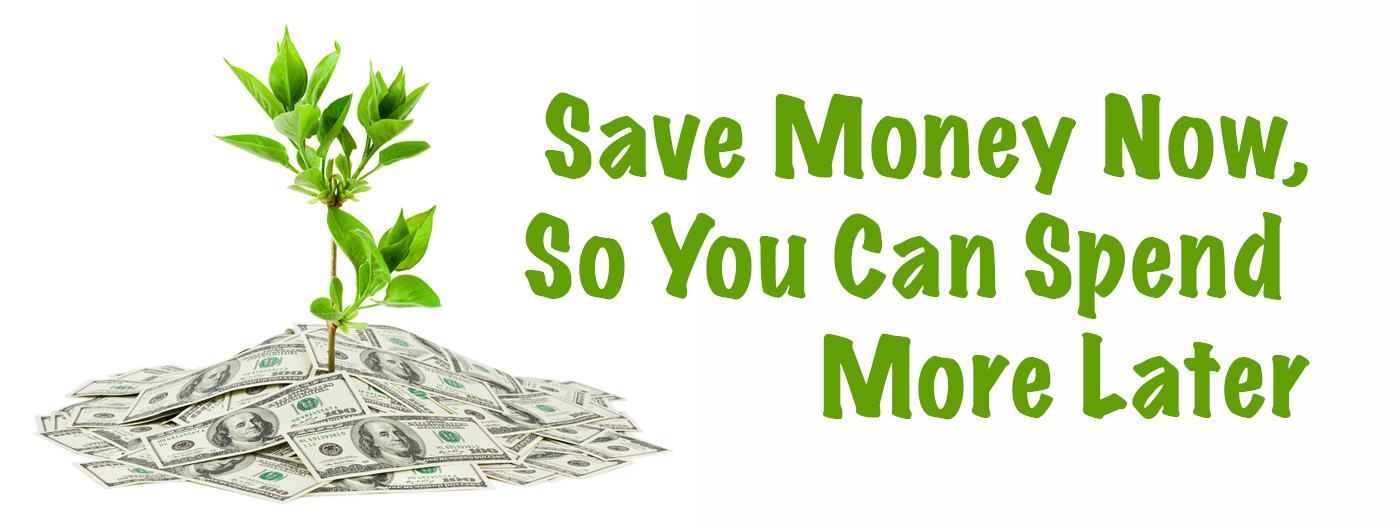Save More Now, So You Can Spend More Later
by Sid Raisch
The best time to save money is to reduce spending precisely when and where we are spending the most.
There is never a time that we spend more than right now in the peak of spring in this business. Reducing spending by a small percentage now yields greater dollars of savings than saving a big percentage, but a small amount in July, August, January, or February. Let’s spend less all the time.
Financial Guru Dave Ramsey is famous for saying, “If you’ll live like no one else does today, you can live like no one else can later.” This applies to personal spending and also company spending. The money to do things we want to do in the future is being earned this spring. It won’t be (and can’t be) made at any other time before spring again next year. That’s a long time to wait. Not saving (over-spending) will erase the gain before our eyes and we will never be able to do the things we will wish we could do later if we spend the money needed to do those things now.
Plan to Save - The best way to save is to plan to save. Set a calendar date for the sole purpose to review spring spending in July, and make changes to your plans then for saving money Spring of 2024. You’ll be able to save more money by planning ahead but don’t let that stop you from saving what you can over the next 4 to 6 weeks. A savings plan will require more action than just not spending money that doesn’t need to be spent now, it will also mean actually moving money into a savings account. What we will be saving and protecting is the profit we’re earning now in peak spring.
Saving on Cost of Goods – This is the largest expense in retail and provides the greatest opportunity to save money. As our revenue accelerates toward the peak revenue weeks we also rapidly approach the other side – the rapid deceleration of revenue. Turning off the faucet of incoming product is necessary, or inventory will continue to grow while revenue declines. Bloated inventory shrinks as it gets marked down, discounted, reduced, moved, dusted, and moved again, AND WATERED. It is okay to start running out of things as the Spring season draws to a close, and traffic drops. In fact, if inventory doesn’t decrease dramatically, we’re not doing it right. On a GroupTalk LIVE! call some years ago the great philosopher and former garden center owner Mike Berns said he was going to go through his store and talk with all of his people on the morning of Mother's Day Saturday to tell them to STOP ordering and sell down what they have on hand. That may not be appropriate for your situation, but on what date would it be appropriate to stop ordering as a rule, except for the exceptions so you can reduce inventory to match the level of future customer traffic that we KNOW is NOT coming in just a couple of weeks from now?
Saving on Wages – This is the second largest expense in retail. The trouble is, once the paycheck is issued, the cost is locked in. We hire a lot of people under the premise that it is a seasonal job, yet don’t actually end the job as promised, while customer traffic starts declining. Look at revenue history and set the last day of work for seasonal hires ahead of time. Maybe by some stroke of extreme luck (not when preparation meets opportunity), good weather may extend the season a few days or a week or two and inventory that would have become excess sells at full price, but it is better to reduce staff while revenue declines than to overspend money you can’t go back and retrieve. Is there anyone in the organization who, based on lack of performance, or organizational structure changes, should be finding a new team to work with? Waiting to make changes that you know need to be made is also spending money that should be saved.
Saving on Operating Expenses – It seems like operating expenses are pretty well fixed, except they aren’t. When we get into our peak revenue period we get sloppy and there is a strong tendency to over-order supplies, as if the use of them will continue at the higher rate of our peak weeks. Inventory of non-revenue producing back-stock of supplies is a drag on the bottom line.
What is NOT Saving?
If we save money buying things we shouldn’t be buying, we’re not really saving money – we’re spending money that we shouldn’t be spending
Deferred Maintenance is NOT Saving – There is a cost to keeping (maintaining) appearances, kicking the can down the road on keeping working assets in working condition ends up costing more later. It costs less to properly maintain facilities and equipment than to repair them. Preventive Maintenance is like money in the bank – it creates more uptime vs. the high cost of downtime.
Spending is Not Saving - Getting a great deal on a Depreciating Asset (that doesn’t earn money) is a big and expensive WASTE. Many people get confused by leases and loans on vehicles that are company-provided benefits, largely for personal use. There’s a great deal on every truck lot because the prices are inflated to start with, and they need those deals to swindle, I mean help justify the emotion of buyers to commit to paying for something that will be worth 20-30% less at exactly the second the electronic signature is signed. Certainly, it is a false economy to borrow to save money while we pay for depreciation after it occurs – generally, an entire year or two at the end of the payments because the first few years of payments go to interest. If not paying cash, the high cost of monthly payments will still be around 80 months after the mood in which they were committed has faded. Might as well buy gold thread-laced toilet paper.
Now that we’ve tackled saving money, let’s talk about INVESTING the money we’re earning.
Invest in Yourself and Your Team First – Now, while you’re experiencing the extreme pressure of spring think about how your life could be easier. What do we need to learn, become, have, or do to make ourselves and our team operate more smoothly during the peak season next year? We know that if we don’t take steps in these directions before we get there we’ll be dealing with the same stresses the same time next year. More than thinking about this, let’s take time to huddle with the team over it and take notes and plan a date in July to review and take action on them.
Invest to Create Perceived Value – Better appearances of the retail selling environment are one of the most important methods of smart retailers to create perceived value, earning prices that generate profit that other retailers never earn. A pint of paint and an hour of time adds a LOT of perceived value at a low cost. Go paint something that needs painting first, then paint something that will add value to the presentation of your products. There may be some ego gain from this but much more than that it is an investment in creating profit.
BEWARE – Cash Euphoria
A big slushy bank account is a dangerous thing to have access to. You know what I mean. The huge balance that grows daily until about the middle of June creates a false sense of well-being and is too convenient. The balance will be shrinking fast as deferred vendor billing is paid and expenses exceed income during the slower months of July and August which are rapidly approaching. And what about September through next April which typically also cost more than they bring in? Too many garden centers start getting into their line of credit in the fall.
Spend Less, Invest Right, Profit More.
Thinking like this isn’t common. These means of saving and investing don’t just happen by reading about them either. “Watching” the finances is not the same as fixing them. We have to create the means to operate within if we’re going to operate within our means. I’m here to help. Send a text to connect while you’re thinking about it, before you and your money get distracted away from you again, and I’ll get in touch to set it up. 937-302-0423.


Before procrastination or other busyness steals another year from you Text or Call 937-302-0423 or send an email to [email protected] .
Sid Raisch is an advocate for family business leading growth, change, and results throughout US horticulture. Redefining the business future for consumer horticulture by understanding how the end-to-end supply chain needs to be redirected is a skill Sid has honed into an art. He has understanding and insight through inquisitive observations and extensive experience and has served as a trusted advisor helping transform both national and local businesses into more profitable and sustainable businesses. Developing national and international educational programs that create change in culture, community and company provides Sid venues with a front row seat creating effective and innovative business models.
Sid is a Certified Value Builder System Advisor, and currently serves as Chief Strategist and the Swiss Army Knife of Consultants to The Garden Center Group clients. Contact Sid at [email protected] or call or text 937-302-0423.
REMEMBER: Your interaction (by phone and email) with Group Service Providers such as Sid Raisch, Tim Quebedeaux, Jean Seawright, John Kennedy, and of course Danny Summers are included in your retainer!

